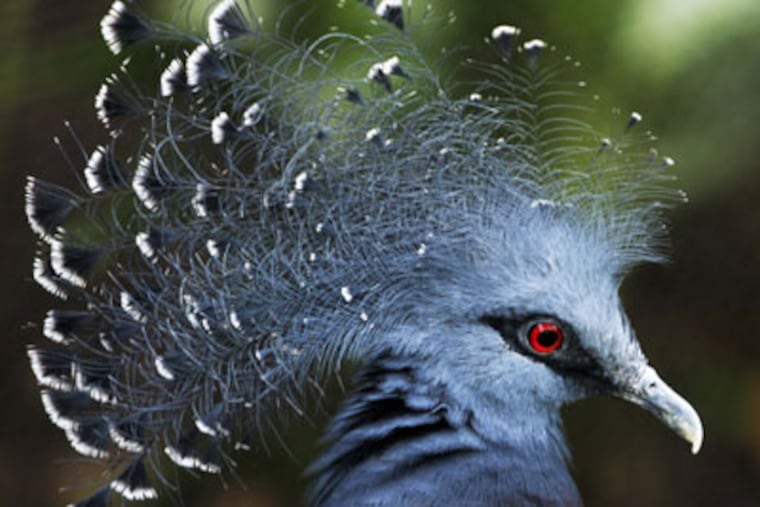
The Philadelphia Zoo's storied history of lovable animals is known to all. There was Massa, the oldest western lowland gorilla when he died at the age of 54 in 1984. Gus and Stella, the young giraffe couple, can be seen necking in all seasons. Jezebel and Vinkel are the first white lions exhibited in the United States.
Now get ready for a new star - Otis the Oriole, who will make his public debut this weekend as the McNeil Avian Center, the zoo's modernized birdhouse, opens to the public.
Otis is the star of the "4-D Migration Theater" that is the centerpiece of the McNeil center, a $17.5 million update of the original 1916 neoclassical birdhouse, whose ornamental façade is integrated into the new exhibit.
As with many parts of the zoo, the McNeil Center tries to display both the global and the local, showing birds from all over the world and spotlighting others that visitors can see in their backyards.
Migration Theater is a good example. There, visitors will follow the animated Otis, an oriole born in Fairmount Park, just a few yards from the zoo. A film tracks him through his first migration south to Central America for the winter and then back to Philadelphia, where he sets up his home nest as a young adult bird. Those watching the film will feel the cool breezes that transport Otis and will see animated, still and filmed shots of all his habitats.
"If this helps us to start the next generation of bird watchers with something like this, I would be ecstatic," said Andrew J. Baker, the zoo's chief operating officer. "The whole idea of the center is to see birds in a different way."
Baker said the zoo chose an oriole, despite its natural connection with Baltimore, because it can be found locally in the warmer months, but also because, unlike the ubiquitous robin, for example, the oriole migrates away in the colder seasons. The exhibit then can spotlight Cape May, one of the great flyway stopovers in the world.
"The point of a zoo exhibit is to use what you learn and go farther afield," said Baker. "If we show people what they can do as close as Cape May, to count birds, to see them migrate, then we have done our job."
Another part of the job is to show off the exotic creatures. The McNeil Center's core is simulated habitats - an African savannah, tropical rain forests, Pacific islands and a Central American shade-grown coffee plantation. In each place, visitors will see colorful birds - from blue-breasted kingfishers to Bali mynahs to Victoria crowned pigeons - and will learn of predators and the fallout from development that endangers them.
"The crowned pigeons are the largest pigeons in the world and are exotic," said zoo bird curator Aliza Baltz. "But we want people to realize they can have the exotic right here. I have birding friends from the West Coast, and when they came here, they saw a cardinal for the first time."
Baltz said that her staff will be in the building often, making sure birds come down to human-eye level. As part of the zoo's husbandry, curators must weigh birds to make sure they are eating right and are free of illness. Accordingly, they have trained the birds to fly down to get on lower-lying scales, a "trick" of sorts that will allow visitors to see some of the birds up close.
"The term bird-brain is a real misnomer," Baltz said. "We can easily train them and they are actually pretty smart."
The building itself is a piece of "green" renovation - marking the third major renovation since it was constructed more than 90 years ago. This time, according to vice president of facilities Nina Visbee, the zoo drilled about 50 geothermal wells 500 feet deep to where the air is a constant 55 degrees. Then, through the piping system, warm air in the summer will be circulated down to cool and vice versa in the winter, not only making it cheaper to maintain a constant temperature, but doing so in an environmentally pure way.
At the end of the exhibit, after seeing the cheery Otis start building his nest, visitors will be reminded that it isn't just exotic toucans and tanagers that should entice, but also local blue jays and woodpeckers.
"Whether it is Cape May or Hawk Mountain or Brigantine or right near the airport at the John Heinz wildlife area, this is a place people come from all over the world to see," said Baker. "We want people to go into their parks and their backyards and become involved with birds in a new way."
See The Inquirer's illustration of the new McNeil Avian Center at http://go.philly.com/aviancenter.
EndText
McNeil Avian Center
The Philadelphia Zoo, 3400 W. Girard Ave.; 215-243-1100. www.philadelphiazoo.org. McNeil Avian Center free with zoo admission. Ongoing exhibits and attractions include the popular Peco Primate Reserve, Rare Animal Conservation Center, Bank of America Big Cat Falls, Children's Zoo and more. Admission: $18; $15 children ages 2-11; free for children under 2. Open daily 9:30 a.m.-5 p.m.
EndText